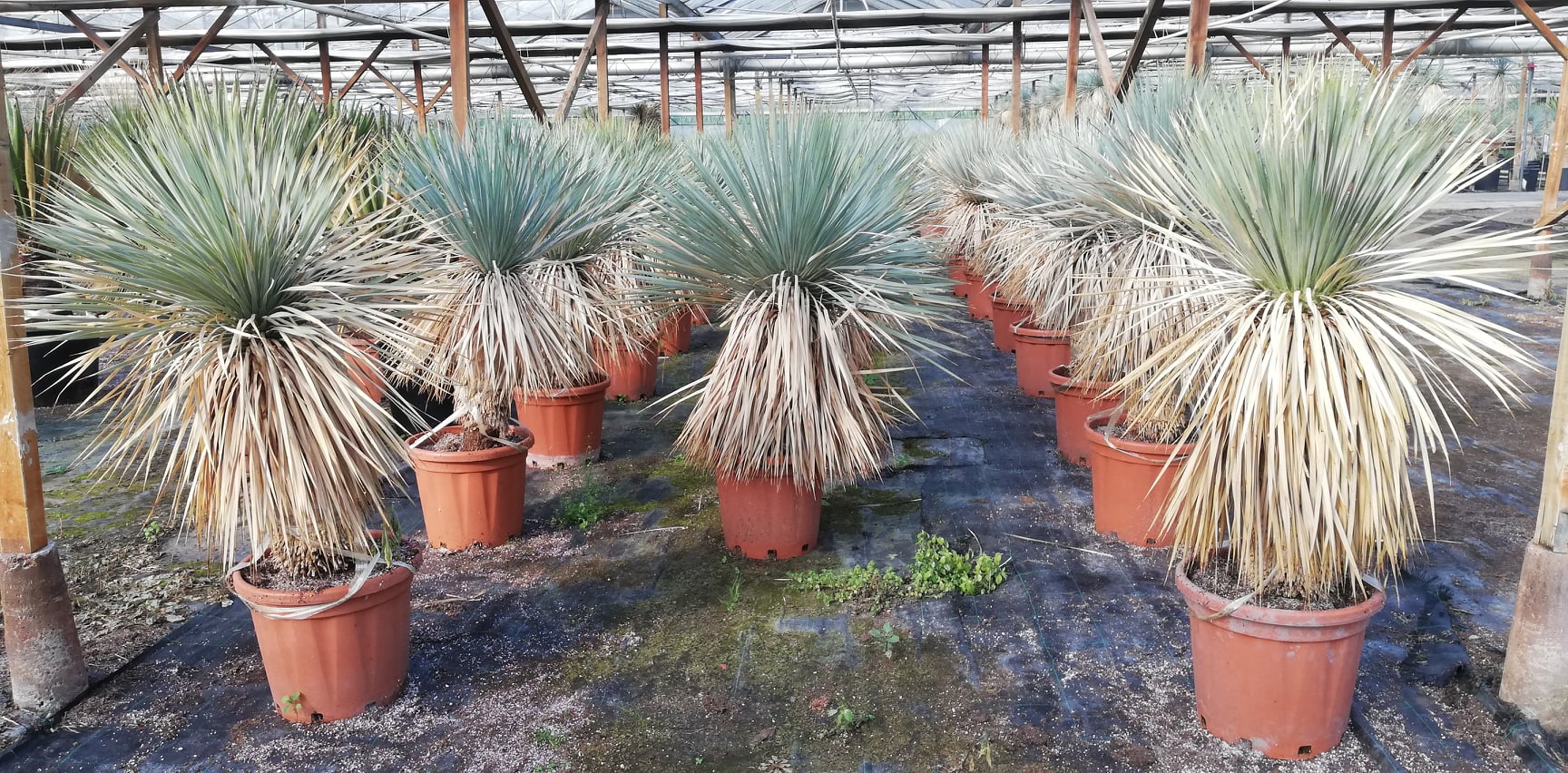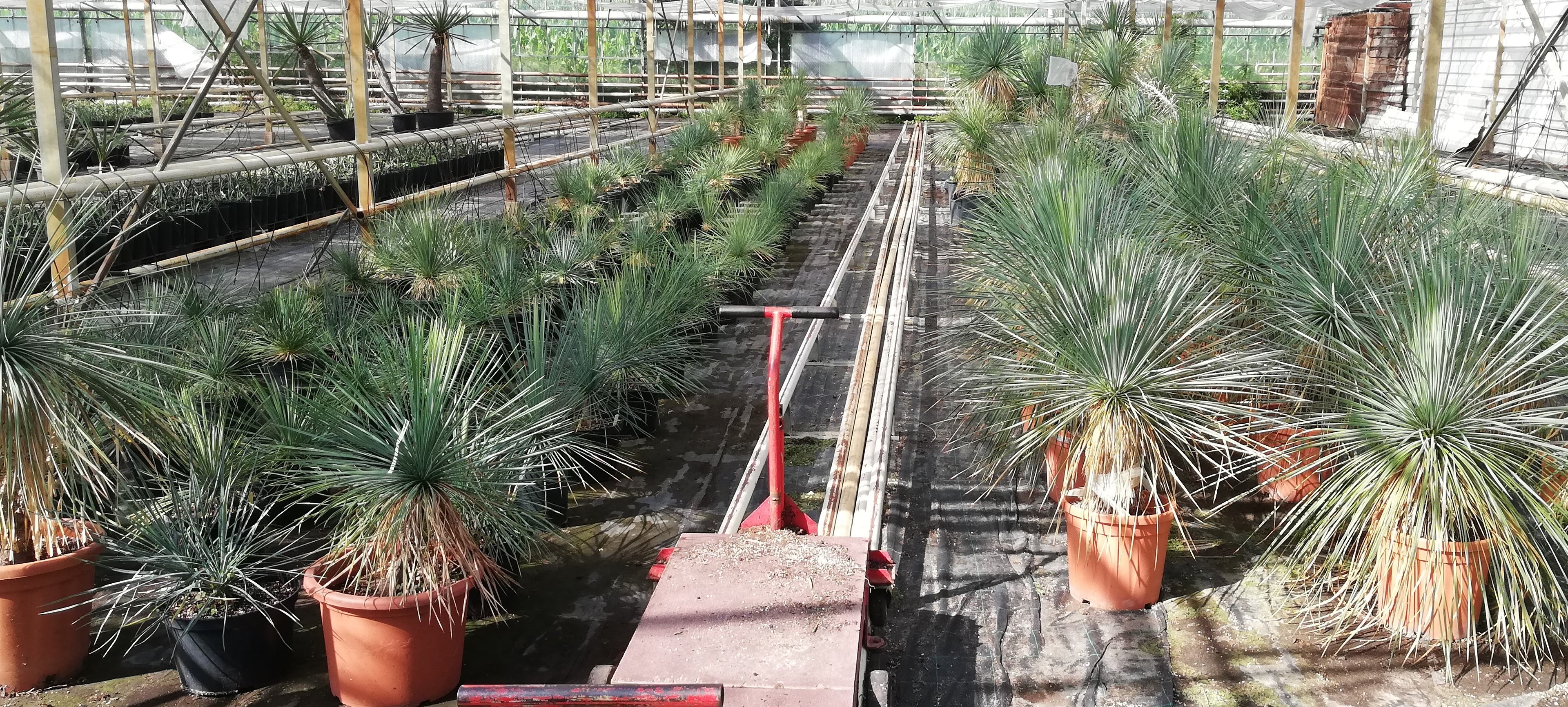

About Yucca:
The Yucca genus consists of a wide variety of about 30 species from Mexico and 50 species from the USA, from stemless or stem-forming yuccas up to 15 meters high!
The leaves differ in thickness and curvature, a property that is important for identification. Most leaves end in a point that varies from blunt to life-threateningly sharp. The roots are strong, fibrous and thread-like and some species create new plants via the rhizomes, which ensure that in case of damage to the mother plant, such as wildfires or frost damage in our garden, new plants sprout from the base, even if the mother plant is destroyed.
Yuccas are very suitable as a container plant, conservatories (cold and warm), indoor gardens, but also for outdoors. Tropical Centre specializes in cold-resistant yuccas from Mexico and North America.
Planting Yuccas and Agaves in the garden:
Although Yuccas, like Agaves, can be very hardy, they can die after winter time due to incorrect care, for example by planting unrooted specimens too late.
The death of a yucca or agave usually has nothing to do with frost resistance, but is because yuccas and most agaves are sensitive to moisture, and in the winter months the humidity is at its highest and rotting of the crown can occur. Well-known Yucca rostrata can do well for years without protection, but then all of a sudden it can happen! Some protection of only the head in the wettest cold months Jan-February is therefore 100% recommended, this can be done by placing a transparent plastic bag over the crown, do not tie it tightly but provide ventilation.
Lesser known Yuccas such as the Y.faxoniana, Y.treculeana, Y.torreyi and Y.elata, are less affected by this and almost indestructible. The longer a yucca is in the garden, the stronger they get. The root system fulfills a very important function in this, so it must be developed before the start of winter! Your plant can also die due to late or incorrect planting.
Which substrate:
Ensure good drainage when planting. A groundwater level that is too high is fatal due to root rot that can occur, an impenetrable soil layer leads to a soil that is too moist, so drainage is a first requirement for this and other sun-loving succulents.
Planting depends on the type of soil in your garden, if you have a water-permeable sandy soil, you can plant the yucca directly. We recommend placing some crushed rubble, hydro granules or gravel mixed with sand or potting soil under the pot and placing the purchased yucca with pot in the ground, you can drill some more holes in the pot, but that is not really necessary.
We recommend this because the roots can break off quickly with removal from the pot, this also happens if you ever want to transplant the yucca, 90% chance that all the roots will break off and the plant will have to root again. If you plant the yucca with a pot, you will get rid of both problems, the yucca roots will find their own way and continue to grow through the drainage holes at the bottom of the pot, remember not to put a water hose in the pot!
In general you do not have to water yuccas, of course there is much more rain here than in Mexico or states such as Texas.
In gardens with clay soil this is also possible provided the drainage of the entire plot is good, yuccas also grow well in clay soil. If the drainage is not good, it is best to work with elevations, so place the plants on the clay soil and apply a mountain of sand around the pot to ensure good drainage. If the plot did not drain well and you would dig a hole with good drainage for planting the yucca, you have made a drainage well in your garden so that the planting hole fills up unseen, this can only be seen if you put the plant there.
You should then apply gravel, boulders, flagstones or lavalite around the neck or trunk of the plant, so that the pot rim is concealed and no water or wet mud remains against the trunk of the plant. In some trunk-forming yuccas, such as the treculeana, trunk rot occurs quickly if there is wet soil against the trunk.
A thick layer of gravel with boulders etc., also provides a real desert look and with some sunshine ensures that the garden heats up faster and longer retains heat, which benefits the yuccas and agave roots.
Do you still want to remove the Yuccas from the pot:
Although the roots are normally strong, as explained before, taking them out of the pot is usually not without damage. They don't grow quickly like a solid clod that you are normally used to taking from a pot, but they break down quickly when they are removed from the pot, due to the weight of soil between the roots, especially when the soil is wet. The greatest chance that it will go well is with a bone-dry clod. Of course most people are shocked when the roots break off, but this is absolutely no problem because the plants are also imported bare rooted and survive for months without roots. It is important that Yuccas without a good root system should not be planted outside later than the beginning of September, as these then not rooted in time to be hardy enough for the winter.
About the Species in general:
Yuccas can be used as a container plant, planted outside and with enough light as an interior plant. Before planting outside, please check the winterhardiness of the specie (f.i. not suitable for temperatures below -10°C are the varieties Y.Rigida and Y.filifera). Most of the other varieties can be planted outside if the rules are followed and of course there is a larger risk of survival than planting a yew or oak tree.
